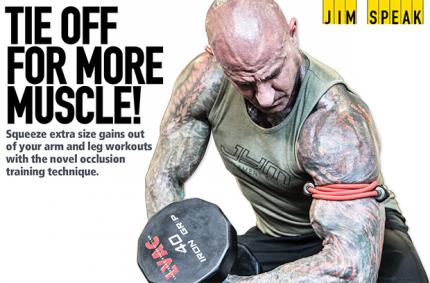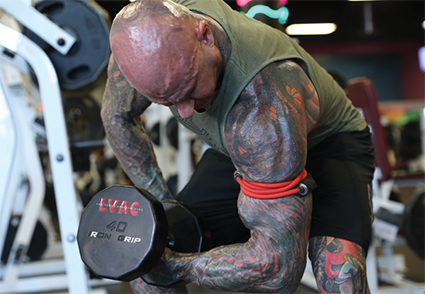Jim Talk

Jim Stoppani, PhD, earned a doctorate in exercise physiology with a minor in biochemistry from the University of Connecticut (Storrs) before serving as a postdoctoral research fellow at Yale University School of Medicine. In 2002, he was awarded the Gatorade Beginning Investigator in Exercise Science Award by the American Physiological Society for his groundbreaking research. For the next 10+ years, Dr. Stoppani served as Senior Science Editor for Muscle & Fitness, Muscle & Fitness Hers and FLEX magazines at Weider Publications. In 2013, he created his breakthrough sports nutrition company JYM Supplement Science, which now includes a line of eight top-selling products.

Tie Off More Muscle (Occlusion Training)
By Jim Stoppani, PhD
Squeeze extra size gains out of your arms and legs with the novel occlusion training technique. If you’ve tried everything to get your arms or legs to grow and they still won’t budge, maybe it’s time for something novel, something advanced.
Incorporating different exercise variations and subjecting your muscles to new intensity techniques and periodization schemes is usually your best bet. But to ignite some truly intense—and painful—shock treatment, consider whipping out a set of bands and trying occlusion training (aka “blood flow restriction” or BFR training). For lagging biceps, triceps, quads, or hamstrings, occlusion might just be the spark you need to ignite new size and strength gains.
What Is Occlusion Training?
 It may sound complex, but it’s pretty simple. Occlusion training involves using a tourniquet—typically in the form of an elastic band, cuff, or strap—on a working body part to restrict blood flow to and from the focus area. Essentially, what you’re doing is creating a hyper-anaerobic environment within the muscle.
It may sound complex, but it’s pretty simple. Occlusion training involves using a tourniquet—typically in the form of an elastic band, cuff, or strap—on a working body part to restrict blood flow to and from the focus area. Essentially, what you’re doing is creating a hyper-anaerobic environment within the muscle.
Normally when training, you have blood flowing to the working muscles to provide oxygen as well as leavingthe muscles to clear waste products created by intense contractions. With occlusion training, you’re cinching off the area so that the blood can’t leave; instead, it pools in the muscle for the duration of the exercise.
According to research, most notably by Japanese scientist Dr. Yoshiaki Sato while using his patented KAATSU “blood flow modification” method, the pooling environment results in increased nitric oxide production and growth hormone secretion in the body, as well as lactic acid buildup in the target muscles, which in turn leads to more size and strength.
One key feature of occlusion training is that it delivers these results via extremely light loads. I’m talking a weight you can normally do for 30, 50, or more consecutive reps. This can be highly beneficial for people who have joint issues, are rehabbing an injury, or simply want to gain size minus the wear and tear that comes from heavy weights.
Should You Use Occlusion Training?
 I’m definitely a believer in the benefits of occlusion training, but I’ll be honest, it’s not the most practical way to train. Aside from requiring additional equipment (occlusion bands or straps) and having to secure it correctly before doing the exercise, you’re limited to what body parts you can use occlusion training for—pretty much just the arms and legs, since there’s really no way to block blood flow to the chest, lats, delts, or traps. Also, occlusion training is very painful. Give it a try and you’ll see what I mean. That’s what happens when you don’t let blood flow freely to and from a hard-working muscle!
I’m definitely a believer in the benefits of occlusion training, but I’ll be honest, it’s not the most practical way to train. Aside from requiring additional equipment (occlusion bands or straps) and having to secure it correctly before doing the exercise, you’re limited to what body parts you can use occlusion training for—pretty much just the arms and legs, since there’s really no way to block blood flow to the chest, lats, delts, or traps. Also, occlusion training is very painful. Give it a try and you’ll see what I mean. That’s what happens when you don’t let blood flow freely to and from a hard-working muscle!
That said, if you’re looking to spark new growth in your arms or legs and have already implemented other proven methods such as periodization, supersets, drop sets, and rest-pauses, give occlusion training a go.
Occlusion Training Cheat Sheet
For the best possible results, here’s a quick guide to implementing occlusion training:
When to do it: As I just mentioned, use occlusion training for bicep, triceps, quads, or hamstrings. If you’re new to it, I recommend implementing it for only one exercise per workout and no more than once a week per body part.
Timing and volume: Save occlusion training for the end of your workout so that it doesn’t fatigue you for other exercises performed with standard sets and heavier weight. To be safe, at least the first time out, adjust your training volume as well. For example, if you’d normally do three exercises for biceps, cut that down to two, with the second one utilizing occlusion training. (See the sidebar for the best exercises to use with occlusion training.)
What kind of band to use: You can find occlusion training bands any number of places. KAATSU sells its own bands (katsu-global.com), but they’re expensive ($150 and up). For something more in the $20 to $30 range, search “Occlusion Training Bands” on Amazon. Better yet, use elastic bands, straps, or knee wraps that you already own.
How to secure the bands: If you’re working biceps or triceps, apply the band just below your shoulder. If you’re training one arm at a time, do notput a band on the non-working arm; if it’s a bilateral exercise, put a band on each arm. When training quads or hams, secure the band(s) just below the hip crease. As for tightness, the expert consensus is that the bands should be roughly a perceived 7 on a scale of 1 to 10. You want them snug, but not so tight that all circulation is cut off.
Sets, reps, resistance, rest: Keep all of your occlusion training sets very light, using a weight that you could normally use for 40 to 50+ reps. If that means using 15-pound dumbbells on curls, so be it—this isn’t an ego exercise! Keep your reps strict and under control. Shoot for 2 to 3 sets of anywhere from 15 to 30 reps; as you get more accustomed to the technique, work up to 4 or 5 sets. In between sets, keep the bands secured in place and rest periods brief—15 to 30 seconds.
Best Moves for Occlusion Training
Certain exercises lend themselves better to occlusion training than others. Here’s a brief menu of ideal occlusion exercises:
Biceps: Concentration curl (one arm at a time), dumbbell curl (one arm, both arms simultaneously, or alternating), barbell curl, machine preacher curl, cable curl (one arm or two arms), band curl.
Triceps: Cable press-down (one arm or two arms), dumbbell or cable kickback, lying triceps extension, machine triceps extension, band press-down.
Quads: Leg extension, sissy squat, lunge (dumbbell or bodyweight), squat (dumbbell, goblet, or bodyweight), machine hack squat, leg press.
Hamstrings: Lying leg curl, seated leg curl, exercise ball curl (roll-in).
Get articles like this one delivered to your email each month by signing up for Muscle Insider’s mailing list. Just click here.

